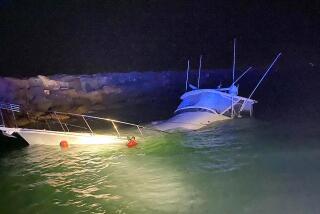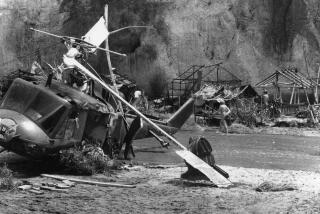Defense Calls Fatal Boat Crash ‘Bad Luck’
- Share via
Virl Earles, who crashed a boat into a concrete buoy in Anaheim Bay, killing five people, was “the unluckiest man I ever saw,” his attorney told a Superior Court jury Monday.
Attorney Gary Pohlson told jurors in his closing arguments that the boat crash was “a misfortune, the darndest unluckiest thing to ever happen to Virl Earles; but it was just an accident . . . bad luck is not a crime.”
Jurors began deliberations Monday afternoon to determine whether Earles is guilty of five counts of involuntary manslaughter.
The prosecutor charges that Earles was either criminally negligent or had intentionally committed a misdemeanor on the night of Oct. 28, 1984, when his boat struck the 11-foot-wide mooring buoy.
The buoy was in a 5-m.p.h. zone, and Earles by his own admission was operating at no less than 25 m.p.h., and perhaps at 30 m.p.h. The prosecution contends it was probably even faster.
Earles, 30, five other men and three women had gotten into the boat just after midnight at Peter’s Landing and headed through the bay out to the open sea toward the Queen Mary in Long Beach. The crash occurred just after the boat had re-entered the bay on the return trip.
All but one of the survivors, including Earles, were seriously injured. The five killed were: John Bakos, 22; Ronald Myers, 22, and Anthony Sutton, 27, all of Seal Beach, and Kathy Weaver, 24, of Laguna Beach, and Patricia Hulings, 20, of Downey.
Deputy Dist. Atty. John Conley contends that Earles was negligent because he knew he was operating at an unsafe speed, that the six-seat boat was overloaded, and that there were no life jackets aboard.
Pohlson told the jurors that it wasn’t the speed of the boat that caused the crash, but harbor conditions.
Earles testified that he lined himself up between what he thought were the two lights at the ends of the east and west jetties, so that the boat would be traveling in the center of the channel. But the west jetty light was not working and had been replaced by a temporary light outside the bay. By mistakenly lining himself up between these two lights, the defense contends, Earles steered the boat down the left side of the bay instead of the center. He thought he was in the middle of the bay when he struck the buoy head-on.
“The cause of the accident was not the speed of the boat--he could have been driving 100 miles an hour and if he had been in the middle of the channel, like he thought he was, he would not have struck that buoy,” Pohlson said. “The cause was the unsafe harbor.”
But Conley countered in his closing argument that expert testimony showed that if the boat had crashed into the buoy at 5 m.p.h. an hour, the result would have been a few surface cracks in the boat at worst and no injuries to the passengers.
The jurors were taken aboard a boat to the scene last week so that they could see the conditions of the bay at night. Conley, recalling that trip, told them that if the boat had been going just 30 m.p.h., it would have taken 17 seconds for the boat to reach the buoy after entering the bay. Earles testified the crash occurred about 10 seconds or so after the boat entered the bay.
“The speed is the issue here,” Conley said.
Conley lost what could have been some of his best evidence before the trial even started. Because of a police error, the courts would not let him show that Earles had a blood alcohol content that tould have indicated he was drunk when he was driving the boat.
But Conley did touch on the drinking issue. Testimony showed that all the people in the group had been drinking at the Red Onion restaurant that night. In his closing argument, Conley told jurors that when Earles left the restaurant he “felt pretty good at the end.”
More to Read
Sign up for Essential California
The most important California stories and recommendations in your inbox every morning.
You may occasionally receive promotional content from the Los Angeles Times.













